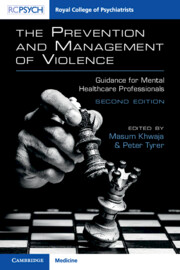Book contents
- The Prevention and Management of Violence
- The Prevention and Management of Violence
- Copyright page
- Dedication
- Contents
- Contributors
- Preface
- Abbreviations
- Section 1 General Aspects of Management
- Section 2 Medical and Psychological Intervention
- Introduction to Section 2
- Chapter 6 Use of Medication and Electroconvulsive Therapy in the Management of Violence
- Chapter 7 Psychological, Psychosocial and Psychotherapeutic Interventions for the Prevention and Management of Violence
- Chapter 8 Prevention and Management of Violence in Inpatient Psychiatric Settings
- Section 3 Violence in Different Settings
- Section 4 Management in Other Groups
- Section 5 Violence and Society
- Section 6 Engagement and Understanding
- Index
- References
Chapter 6 - Use of Medication and Electroconvulsive Therapy in the Management of Violence
from Section 2 - Medical and Psychological Intervention
Published online by Cambridge University Press: 09 May 2023
- The Prevention and Management of Violence
- The Prevention and Management of Violence
- Copyright page
- Dedication
- Contents
- Contributors
- Preface
- Abbreviations
- Section 1 General Aspects of Management
- Section 2 Medical and Psychological Intervention
- Introduction to Section 2
- Chapter 6 Use of Medication and Electroconvulsive Therapy in the Management of Violence
- Chapter 7 Psychological, Psychosocial and Psychotherapeutic Interventions for the Prevention and Management of Violence
- Chapter 8 Prevention and Management of Violence in Inpatient Psychiatric Settings
- Section 3 Violence in Different Settings
- Section 4 Management in Other Groups
- Section 5 Violence and Society
- Section 6 Engagement and Understanding
- Index
- References
Summary
This chapter considers the use of medication as an emergency response in the management of violent and disturbed behaviour. It addresses the complex factors surrounding the decision to use rapid tranquillisation, followed by reviewing the risks and benefits of specific medication options. This is discussed within the context and continuum of acute patient care, in keeping with good practice principles, and with consideration to the relevant patient-related and medication-related risks. The current evidence for using medication or ECT in the management of a medium- and longer-term risk of violence in the context of mental illness is briefly reviewed. The recommendations are applicable to all inpatient mental health units in the United Kingdom.
Keywords
- Type
- Chapter
- Information
- The Prevention and Management of ViolenceGuidance for Mental Healthcare Professionals, pp. 76 - 106Publisher: Cambridge University PressPrint publication year: 2023

